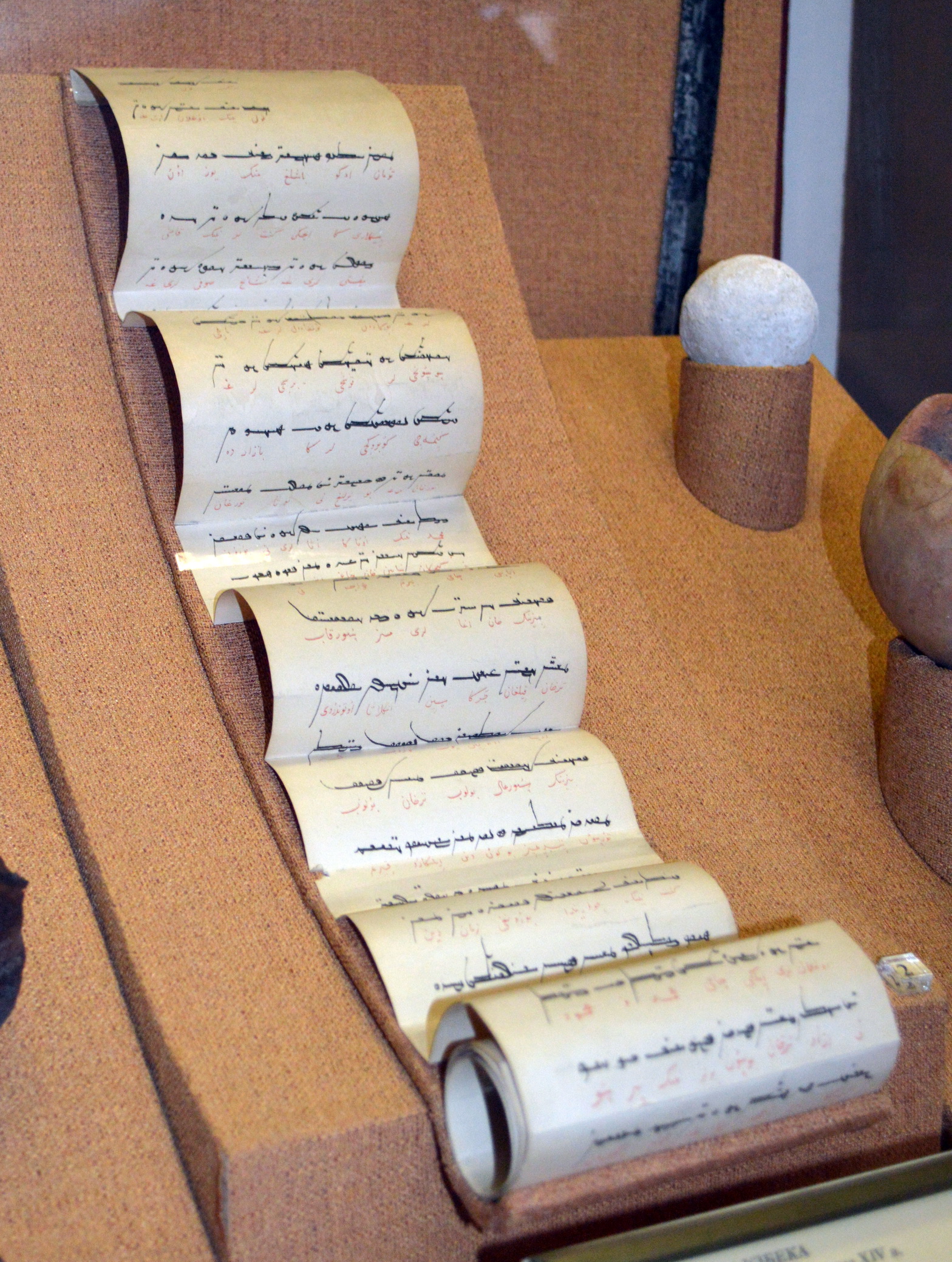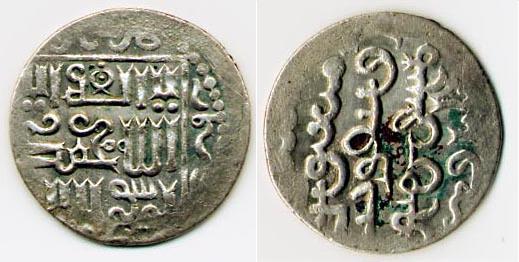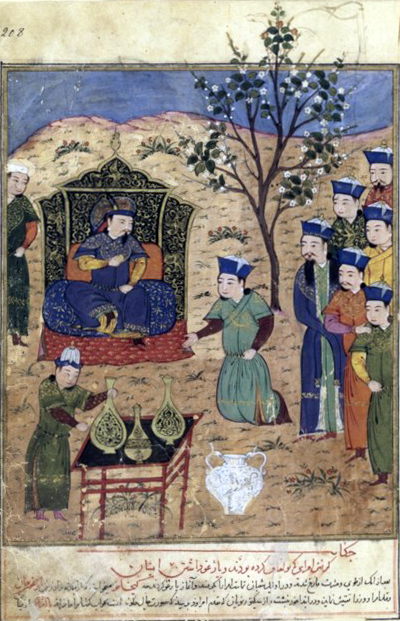|
Qutb Al-Din Mohammad
Qutb al-Din Mohammad — was Qutlughanid ruler of Kerman and a nephew of Buraq Hajib, founder of dynasty. Life He was a son of Hamīd Pur (or Khan Temür), thus a nephew of Buraq Hajib. His father was an emir in service of Khwarazmshah dynasty, who served as commander of Bukhara in c. 1220. First reign and exile He succeeded his uncle Buraq Hajib in 1235 and married Kutlugh Turkan on 5 September 1235. However, his reign was very short as he was quickly replaced by his cousin Rukn al-Din on the order of Ögedei Khan. He left for Mongolia through Shahdad-Zozan route and was ordered to join Mahmud Yalavach in China as soon as he arrived. He was present at Güyük Khan's election in 1246, from whom he asked to be recognized as ruler of Kirman once again. However, this was discouraged by Güyük's trusted advisor Chinqai ( 镇海) who was a tutor to Rukn al-Din previously. Second reign His aspiration to rule Kirman again was realized after Güyük's and Chinqai's subsequent d ... [...More Info...] [...Related Items...] OR: [Wikipedia] [Google] [Baidu] |
Qutlugh-Khanids
The Qutlugh-Khanids (otherwise known as the Qutlugh-Khanid dynasty, Kirmanid dynasty, or very rarely as the Later Western Liao) was a dynasty of ethnic Khitan origin that ruled over Kirman (in present-day Kerman Province, Iran) from 1222 to 1306. It was founded by Buraq Hajib, who emigrated from the Qara Khitai (Western Liao dynasty) during the collapse of the realm. Originally an independent entity, the Qutlugh-Khanid dynasty subsequently ruled as vassals of the Khwarazmian dynasty, the Mongol Empire and the Ilkhanate. The dynasty was removed from power by the Ilkhanid ruler Öljaitü, who appointed Nasir al-Din Muhammad ibn Burhan as governor of Kirman. Later Western Liao Although there was no mention of a dynasty called the "Later Western Liao" (后西辽) in traditional Chinese scholarship, Wang Zhilai wrote a paper ''On the Later Western Liao'' (关于"后西辽") in 1983, where he proposed to call the Qutlugh-Khanids the "Later Western Liao", thereby positioning the dyn ... [...More Info...] [...Related Items...] OR: [Wikipedia] [Google] [Baidu] |
Jarlig
A jarlig ( mn, зарлиг, zarlig; russian: ярлык, ''jarlyk'', also transliterated yarlyk in Russian and Turkic, or even more correctly yarlıq, and the Tatar: yarlığ) is an edict or written commandant of Mongol and Chinggisid rulers' "formal diplomas". It was one of three types of non-fundamental law pronouncements that had the effect of a regulation or ordinance, the other two being ''debter'' (a record of precedence cases for administration and judicial decisions) and ''billing'' (maxims or sayings attributed to Genghis Khan). The jarliq provide important information about the running of the Mongol Empire. Ögedei Khagan prohibited the nobility from issuing gergees (tablet that gave the bearer authority to demand goods and services from civilian populations) and jarliqs in the 1230s. From the mid-13th to mid-15th centuries, all princes of Northeastern Rus received jarliq authorizing their rule. The issuing of jarlyk on governing of Rus finalized the establishmen ... [...More Info...] [...Related Items...] OR: [Wikipedia] [Google] [Baidu] |
13th Century In Iran
In music or music theory, a thirteenth is the Musical note, note thirteen scale degrees from the root (chord), root of a chord (music), chord and also the interval (music), interval between the root and the thirteenth. The interval can be also described as a Interval (music)#Simple and compound, compound major sixth, sixth, spanning an octave plus a sixth. The thirteenth is most commonly major or minor . A thirteenth chord is the stacking of six (major third, major or minor third, minor) thirds, the last being above the 11th of an eleventh chord. Thus a thirteenth chord is a tertian (built from thirds) chord containing the interval of a thirteenth, and is an extended chord if it includes the ninth and/or the eleventh. "The jazzy thirteenth is a very versatile chord and is used in many genres." Since 13th chords tend to become unclear or confused with other chords when Inverted chord, inverted, they are generally found in root position.Benward & Saker (2009). ''Music in ... [...More Info...] [...Related Items...] OR: [Wikipedia] [Google] [Baidu] |
1257 Deaths
1 (one, unit, unity) is a number representing a single or the only entity. 1 is also a numerical digit and represents a single unit of counting or measurement. For example, a line segment of ''unit length'' is a line segment of length 1. In conventions of sign where zero is considered neither positive nor negative, 1 is the first and smallest positive integer. It is also sometimes considered the first of the infinite sequence of natural numbers, followed by 2, although by other definitions 1 is the second natural number, following 0. The fundamental mathematical property of 1 is to be a multiplicative identity, meaning that any number multiplied by 1 equals the same number. Most if not all properties of 1 can be deduced from this. In advanced mathematics, a multiplicative identity is often denoted 1, even if it is not a number. 1 is by convention not considered a prime number; this was not universally accepted until the mid-20th century. Additionally, 1 is the s ... [...More Info...] [...Related Items...] OR: [Wikipedia] [Google] [Baidu] |
Baydu
Baydu (Mongolian script:; ) (died 1295) was the sixth ruler of the Mongol empire's Ilkhanate division in Iran. He was the son of Taraqai, who was in turn the fifth son of Hulagu Khan.Stevens, John. ''The history of Persia. Containing, the lives and memorable actions of its kings from the first erecting of that monarchy to this time; an exact Description of all its Dominions; a curious Account of India, China, Tartary, Kermon, Arabia, Nixabur, and the Islands of Ceylon and Timor; as also of all Cities occasionally mention'd, as Schiras, Samarkand, Bokara, &c. Manners and Customs of those People, Persian Worshippers of Fire; Plants, Beasts, Product, and Trade. With many instructive and pleasant digressions, being remarkable Stories or Passages, occasionally occurring, as Strange Burials; Burning of the Dead; Liquors of several Countries; Hunting; Fishing; Practice of Physick; famous Physicians in the East; Actions of Tamerlan, &c. To which is added, an abridgment of the lives of the ki ... [...More Info...] [...Related Items...] OR: [Wikipedia] [Google] [Baidu] |
Gaykhatu
Gaykhatu (Mongolian script:; ) was the fifth Ilkhanate ruler in Iran. He reigned from 1291 to 1295. His Buddhist baghshi gave him the Tibetan name Rinchindorj () which appeared on his paper money. Early life He was born to Abaqa and Nukdan Khatun, a Tatar lady in c.1259. He was living in Jazira during Tekuder's reign and had to flee to Arghun in Khorasan after Qonqurtai's execution in 1284. He was given as hostage to Tekuder by Arghun as a condition of truce in June 1284 and put in orda of Todai Khatun, his step-mother. After Arghun's enthronement, he was confirmed as governor of Anatolia together with his uncle Hulachu. Rule in Anatolia He was stationed in Erzinjan and learnt to speak Persian and to some degree Turkish during his stay in Anatolia. Gaykhatu ruled Anatolia solely after recall of Hulachu to Iran in 1286. It was then he was married to Padishah Khatun, a princess of Qutlugh-Khanids. He aided Masud II on his campaigns against Turkmen principalities, most importa ... [...More Info...] [...Related Items...] OR: [Wikipedia] [Google] [Baidu] |
Abaqa Khan
Abaqa Khan (27 February 1234 – 4 April 1282, mn, Абаха/Абага хан (Khalkha Cyrillic), ( Traditional script), "paternal uncle", also transliterated Abaġa), was the second Mongol ruler (''Ilkhan'') of the Ilkhanate. The son of Hulagu Khan and Lady Yesünčin and the grandson of Tolui, he reigned from 1265 to 1282 and was succeeded by his brother Ahmed Tekuder. Much of Abaqa's reign was consumed with civil wars in the Mongol Empire, such as those between the Ilkhanate and the northern khanate of the Golden Horde. Abaqa also engaged in unsuccessful attempts at invading Syria, which included the Second Battle of Homs. Life Abaqa was born in Mongolia on 27 February 1234, son of Ilkhanate founder Hulagu Khan. Abaqa was a Buddhist. A favoured son of Hulagu, he was made governor of Turkestan.Runciman, p. 320. Hulagu died from illness in 1265. Before his death, he had been negotiating with the Byzantine Emperor Michael VIII Palaiologos to add a daughter of the Byzantine ... [...More Info...] [...Related Items...] OR: [Wikipedia] [Google] [Baidu] |
Padishah Khatun
Safwat al-Din Khatun (1256–1295), otherwise known as Padishah Khatun, was the ruler of Kirman from 1292 until 1295 as a member of the Mongol vassal Qutlugh-Khanid dynasty in Persia. Life She was born in 1256, as the youngest daughter of Qutb al-Din (d. 1257) and Kutlugh Turkan of Kirman.Mernissi, Fatima; Mary Jo Lakeland (2003). The forgotten queens of Islam. Oxford University Press. . She already had her own fiefdom in Sirjan thanks to her mother Kutlugh Turkan's visit to coronation ceremony of Abaqa in 1265. Her first spouse was Abaqa Khan to whom she was married on 22 May 1272. The marriage was arranged by her mother to secure Mongolian support for her rule. She was granted Abaqa's late mother's Yesunjin's household. She was instrumental in strengthening rule of her mother Kutlugh Turkan and was her supporter against her siblings Muzaffar al-Din Hajjaj (1276) and Suyurghatmish (1280). After Abaqa's death She did not leave for Kerman after Abaqa's deat ... [...More Info...] [...Related Items...] OR: [Wikipedia] [Google] [Baidu] |
Suyurghatmish
Jalal ad-Din Suyurgatmish was Qutlughanid ruler of Kerman and a son of Qutb al-Din Mohammad. Life His mother's identity is unknown, he had a full sister Ordu Kutlugh who was married to Baydu. He was a childhood friend with Tekuder, son of Hulagu, a connection that would prove helpful in future. An ambitious person, he went to the court of Abaqa to obtain noble rights of his step-brother Muzaffar al-Din Hajjaj in 1279. Having obtained recognition, he arrived at Kerman on 19 September 1280 and forced her step-mother Kutlugh Turkan to make him a co-ruler by 19 October, had the ''khutba'' proclaimed in his name too. A number of members of the court joined Suyurgatmish, including Muiz al-Din Malekshah, a high ranking noble. However she soon "complained to her daughter Padishah Khatun and received a yarligh forbidding her stepson to meddle in the affairs of Kirman". Reign Following Abaqa's death in 1281, he obtained a great power due to his friendship with Tekuder, new Ilkhan. He w ... [...More Info...] [...Related Items...] OR: [Wikipedia] [Google] [Baidu] |
Muzaffar Al-Din Hajjaj
Muzaffar al-Din Hajjaj was a nominal Qutlughkhanid prince of Kerman, a son of Qutb al-Din Mohammad and Kutlugh Turkan. Life Muzaffar al-Din Hajjaj was a minor when his father Qutb al-Din Mohammad died in 1257. Kerman nobles assembled and asked Hulegu for Kutlugh Turkan's appointment as the ruler of the principality. Hulegu confirmed Hajjaj as the new ruler of Kerman, while Kutlugh Turkan was named a regent responsible for civil affairs. Hajjaj's brother-in-law Azad al-Din Hajji was confirmed as the supreme commander, much to Turkan's displeasure, who later obtained full sovereign rights. Hajjaj married Arghun Aqa's daughter Begi Khatun - a woman his father wanted to marry - in 1264. This was the year when Turkan was acknowledged by Hulegu as a ruler in her own right, putting Hajjaj under her shadow. Once he reached adulthood, Hajjaj began to fight at the front of the Ilkhanid army ranks, Chagataid where he achieved fame. This was confirmed when he was honored by Abaqa in 1270 ... [...More Info...] [...Related Items...] OR: [Wikipedia] [Google] [Baidu] |
Hulagu Khan
Hulagu Khan, also known as Hülegü or Hulegu ( mn, Хүлэгү/ , lit=Surplus, translit=Hu’legu’/Qülegü; chg, ; Arabic: fa, هولاکو خان, ''Holâku Khân;'' ; 8 February 1265), was a Mongol ruler who conquered much of Western Asia. Son of Tolui and the Keraite princess Sorghaghtani Beki, he was a grandson of Genghis Khan and brother of Ariq Böke, Möngke Khan, and Kublai Khan. Hulagu's army greatly expanded the southwestern portion of the Mongol Empire, founding the Ilkhanate of Persia, a precursor to the eventual Safavid dynasty, and then the modern state of Iran. Under Hulagu's leadership, the siege of Baghdad (1258) destroyed Baghdad's standing in the Islamic Golden Age and weakened Damascus, causing a shift of Islamic influence to the Mamluk Sultanate in Cairo and ended the Abbasid Dynasty. Background Hulagu was born to Tolui, one of Genghis Khan's sons, and Sorghaghtani Beki, an influential Keraite princess and a niece of Toghrul in 1217. Noth ... [...More Info...] [...Related Items...] OR: [Wikipedia] [Google] [Baidu] |
Jalal Ad-Din Mingburnu
Jalal al-Din Mangburni ( fa, جلال الدین مِنکُبِرنی), also known as Jalal al-Din Khwarazmshah (), Minkubirni or Mengu-Berdi (c.1199 – August 1231), was the last Khwarazmshah of the Anushtegin dynasty, Anushteginid dynasty. The eldest son and successor of Muhammad II of Khwarezm, Ala ad-Din Muhammad II of the Khwarazmian Empire, Jalal al-Din was brought up at Gurganj, the wealthy capital of the Khwarazmid homeland. An able general, he served as second-in-command to his father in Battle on the Irghiz River, at least one battle; however, since he was the son of a concubine, he was challenged as successor by a younger brother, whose cause was supported by the powerful Queen Mother, Terken Khatun (wife of Ala ad-Din Tekish), Turken Khatun. Nevertheless, after the Mongol conquest of the Khwarazmian Empire led to his father's flight and death on an island in the Caspian Sea, Jalal-al Din gained the loyalty of the majority of Khwarazmian loyalists. The new Shah moved to ... [...More Info...] [...Related Items...] OR: [Wikipedia] [Google] [Baidu] |






.jpeg/1200px-Prise_d'Alamût_(1256).jpeg)
